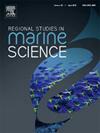基于卫星的马尔马拉海叶绿素-a浓度变异及其与环境变化的关系
IF 2.4
4区 环境科学与生态学
Q3 ECOLOGY
引用次数: 0
摘要
本研究旨在详细了解马尔马拉海叶绿素a (Chl-a)浓度的时空特征及其与环境因子的关系。为此,研究了2005年至2021年4公里分辨率的Aqua MODIS Chl-a浓度数据。此外,还分析了同期的海表温度、气象资料和渔业捕捞资料。在整个研究期间,研究了Chl-a、环境变量和渔业捕获量的时间序列变异性和趋势,以及这些序列之间的相互相关关系。在黑海流入、河流排放、垂直混合、上升流和相关过程的营养波动的驱动下,马尔马拉海从11月到次年4月经历了Chl-a的大量繁殖。净降水和温度也是Chl-a华的重要驱动因素,无论有无时间滞后,均与Chl-a呈显著相关。每月的Chl-a气候学场呈均匀变化,人为活动高的地区全年的Chl-a水平较高。2 ~ 4月,气候学场在博斯普鲁斯出口附近观测到相对较低的Chl-a值。海盆月平均Chl-a时间序列与气温、海温、海表温度呈显著负相关(r = -0.473 ~ - 0.588,p <; 0.01),与净降水呈显著正相关(r = 0.403,p <; 0.01)。高降水可能导致Chl-a升高,并具有延迟效应。马尔马拉海的气温、海温、海表温度(0.049 ~ 0.066°C/yr, p <; 0.01)和蒸发量(0.409 mm/yr, p <; 0.05)呈显著的正趋势。大的黏液事件发生之前,低的Chl-a可能是由于低降水。在这些事件之后,观察到创纪录的高Chl-a浓度,表现出不同的分布模式。本文章由计算机程序翻译,如有差异,请以英文原文为准。
Satellite-based chlorophyll-a concentration variability and its relation to environmental changes in the Marmara Sea
This study aims to provide a detailed understanding of the spatiotemporal characteristics of chlorophyll-a (Chl-a) concentrations and their relationships with environmental factors in the Marmara Sea. For this purpose, four-kilometer resolution Aqua MODIS Chl-a concentration data from 2005 to 2021 were examined. Additionally, sea surface temperature (SST), meteorological data and fisheries catch data were analyzed over the same period. The variability and trends in the time series of Chl-a, environmental variables, and fisheries catches, as well as the cross-correlation relationships between these series, were investigated throughout the study period. The Marmara Sea experiences Chl-a blooms from November to April, driven by nutrient fluctuations from Black Sea inflow, river discharges, vertical mixing, upwelling and related processes. Net precipitation and temperature are also important drivers of Chl-a blooms, showing significant correlations with Chl-a, both with and without time lags. Monthly Chl-a climatology fields show uniform changes, with areas of high anthropogenic activity having higher levels throughout the year. Relatively low Chl-a values near the Bosphorus exit were observed in the climatology fields from February to April. Basin-averaged monthly mean Chl-a time series shows significant negative correlations with air temperature, sea temperature, and SST (r = -0.473 to −0.588, p < 0.01) and a positive correlation with net precipitation (r = 0.403, p < 0.01). High precipitation likely leads to elevated Chl-a, with a delayed effect. Air temperature, sea temperature, SST (0.049–0.066 °C/yr, p < 0.01), and evaporation (0.409 mm/yr, p < 0.05) show significant positive trends in the Marmara Sea. Large mucilage events were preceded by low Chl-a likely due to low precipitation. After these events, record-high Chl-a concentrations were observed, exhibiting different distribution patterns.
求助全文
通过发布文献求助,成功后即可免费获取论文全文。
去求助
来源期刊

Regional Studies in Marine Science
Agricultural and Biological Sciences-Ecology, Evolution, Behavior and Systematics
CiteScore
3.90
自引率
4.80%
发文量
336
审稿时长
69 days
期刊介绍:
REGIONAL STUDIES IN MARINE SCIENCE will publish scientifically sound papers on regional aspects of maritime and marine resources in estuaries, coastal zones, continental shelf, the seas and oceans.
 求助内容:
求助内容: 应助结果提醒方式:
应助结果提醒方式:


